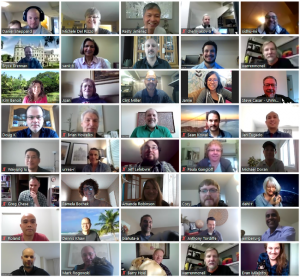From March 13 to April 27, The University of Winnipeg’s Technology Sector handled 702 support calls (460% increase over the same period last year), went from 11 to 479 active Zoom users, and had 5,237 meetings covering 2,181,125 minutes with more than 50,000 participants.
To say they’ve been busy is an understatement. Kim Benoit, Chief Information Officer, described her team as “resilient, dedicated, and committed to enabling our community.”
Of the 57 team members, five are regularly working on campus, seven are going to campus only as is necessary, and 45 are working from home.
“Our team rose to the challenge, kept level heads, embraced change, leading and assisting others on campus with that change, and took definitive action as was necessitated by the situation,” said Benoit.
Following UWinnipeg’s move to remote teaching in mid-March, the Technology Sector’s biggest challenge was the rapid shift to remote learning. At that point, only 40 per cent of UWinnipeg’s courses had online delivery components.
“Many of our faculty and staff were not familiar with the technologies UWinnipeg uses for remote delivery and had to learn quickly both on the teaching and learning side, as well as the administrative side,” she explained. “This learning curve was the biggest challenge and also the reason we chose proven, existing technologies for remote delivery.”
Secondarily to that was the ramping up of the technology itself, which Benoit said was “no small feat.”
While trekking through this uncharted situation, the message to the Technology Sector was always to remember their goal: to enable the university community to fulfill its mission through the provision of high quality, secure, reliable, and integrated technology-based solutions.
“People not normally working in certain areas have been deployed to assist in areas of greater need,” Benoit said. “We have an incredible, dedicated, and innovative team whom have demonstrated their ability to pivot quickly and support what the university community needs.”
But the Technology Sector hasn’t done this alone.
From human resources and emergency preparedness to the academic community and facilities, Benoit said they have received tremendous support and collaboration from the entire UWinnipeg community.
“With the rapid shift from face-to-face to remote delivery, we have become amazingly nimble. Decision-making has become faster with greater focus, we are collaborating more, and there is tremendous willingness to work together, be open-minded, and experiment with innovative solutions,” she said.
“Our circumstances are eliciting greater understanding and compassion amongst students, faculty, and staff at all levels, and are resulting in more flexible work environments.”





